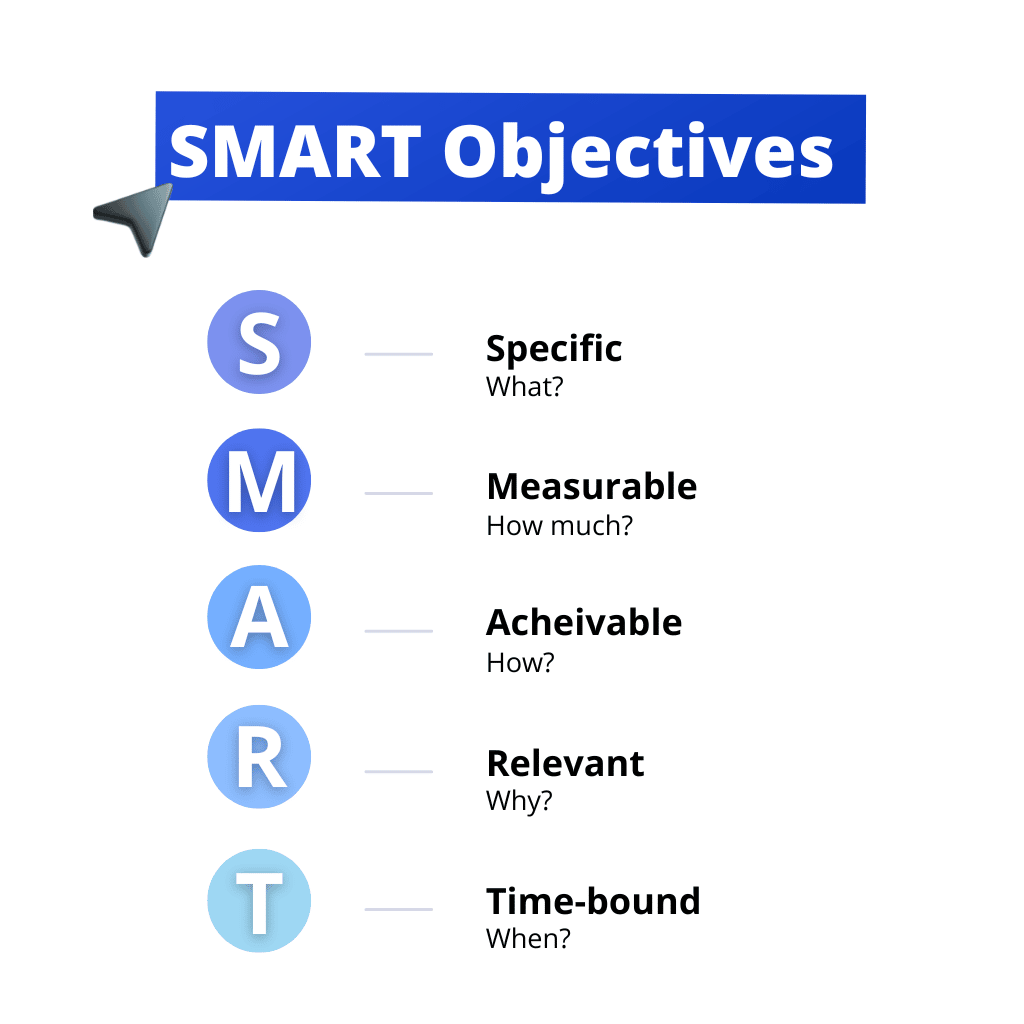- What is are “SMART Goals” or “SMART Objectives”? Definition
- The meaning behind SMART Goals
- The S for Specific
- The M for Measurable
- The A for Attainable
- The R for Realistic
- The T for Time-bound
- Why is the SMART Method so useful in marketing leadership?
- Image of SMART Goals
- The 5 examples of SMART goals
- Conclusion and FAQ of the article
Looking to set SMART goals for yourself, your projects, or your teams? You’ve come to the right place. In this article, you will not only discover the definition of the SMART method, but you will also learn how to use it thanks to concrete examples from the activity sector.
What you can do after reading the article:
- 🚀 Boost your method with the “SMART” technique,
- 🎯 Achieve your goals,
- 🥰 Improve team morale and keep them motivated,
- 📈 Increase your competitiveness.
What is are “SMART Goals” or “SMART Objectives”? Definition
Before the arrival of the SMART method in 1954, the objectives set in companies were vague, difficult to reach, and caused dissatisfaction, both at the salary and managerial levels. Why SMART? There is only one method that can be used universally in any sector of activity.
It was the first time that it was explained that only 4 terms were needed to define objectives, that they were mandatory, and that without them, the objectives set were meaningless.
SMART GOALS Acronym
The acronym S.M.A.R.T. means intelligent in English. It means: Specific, Measurable, Attainable, Realistic, and with a Timeframe.
The measures must therefore be both qualitative and quantitative.
The inventor of this method is Peter F. Drucker, this man. 👇

A true legend of management, he also said phrases that still mark our minds today, like:
“Management by objectives is effective if you know the objectives
But 90% of the time you don’t know them.”
“There is nothing more useless than doing efficiently
something that doesn’t need to be done at all.”
No more bad goals
As we used to say, without these criteria, Marketing objectives quickly become blurred. Unfortunately, some companies still do not apply this method, due to a lack of knowledge or because they consider it too academic, even though it is so effective.
Can you imagine setting sales objectives of +15% to a salesperson, without justifying how they can be reached or what you are basing them on to increase their objectives?
In far too many companies, management and teams disagree about the goals they have chosen. Fix that and learn how to set up smart links! 🦸
The meaning behind SMART Goals
Goal setting is the main criterion for motivating teams to successfully complete company projects and their missions. Set goals that are too difficult to achieve, and they won’t even try to meet them. ❌
If the objectives meet very specific criteria and especially if they have been determined also WITH the teams and not just given to the teams, then you will boost their investment and give all the chances to the projects to be successfully completed. ✔
Only after you have passed these steps can you set the goals. It’s not possible to set a goal for someone who doesn’t know the whole project, you know?
Then you can move on to the next step, setting your goals.
They can be individual or common, depending on the nature of the assignment. A good goal usually has an individual notion to motivate each team member and a common part.
👉 To do this, you can use performance indicators like the ones in the Waalaxy dashboard, in order to track your team’s progress!
The S for Specific
When you define a smart goal , you need to make sure it is”specific”, meaning that the objectives are clear and precise if you want to accomplish it. This is the key to your success and that of your teams.
Let ‘s face it , it ‘s hard to start and finish a project when the goal is unclear or unrealistic.
❌ Examples of unclear objectives:
- “Increase the traffic to our website “.
- “Increase product visibility”.
- “Double the sales”.
- “Increase revenue”.
Resources deployed may be insufficient or excessive without a clear objective . But then, how do you formulate smart goals ?
✔ You need a clear number associated with a time frame, here are clearly defined goals:
- “Increase my prospect database by 20% over the next quarter.”
- “Hire 5 new developers – with a validated trial period, over the next 12 months.”
- “I want to get at least 40 leads per month consistently, over 12 months, starting in January .”
Another important point when it comes to defining a clear goal is a clear division of labor.
If you want to be successful, it is important that no one asks what to do or does someone else ‘s job !
If the objective is clear, each member of the team responsible for the execution of the project knows exactly what to do .
To ensure that everyone knows exactly what their role is to achieve their goals:
- 🥇 Detail each assignment on a shared document, on Notion for example, and write down all the tools and resources needed for the project.
- 🥈 Break down the assignments on a chart according to the employees responsible for the project.
- 🥉 Have the teams validate the missions and roles and answer any necessary questions to avoid unclear areas.
| Maria | Kate | Alex | Clem |
| Mission 1 | |||
| Mission 2 | |||
| Mission 3 | |||
| Mission 4 | |||
Of course, for this step, everything will depend on the number of employees included in the project. If the tasks are set for a single employee – such as asking a salesperson to increase his sales by 20% over the year – the chart will be different. Each table must take into account the specificities of the job and the tasks.
| Salesman 1 | Commercial 2 | ||
| Resources and tools | |||
| Mission | |||
| Temporality | |||
| Objectives | 20% | 12% |
The M for Measurable
The second criteria are very important: measurable results that can be quantified. Without this, there is no way to know if you have achieved your goals if your results are poor or exceed your expectations .
It may seem obvious to you, but I assure you that many companies embark on projects before they even know if it’s measurable or not.
So, we’ve identified the needs and determined the assignments. Now we need to be sure we have quantifiable goals.
🤓 Let’s go back to our examples from earlier.
“Increase my customer database by 20% over the next quarter.”
-
- How do I know the number of users in my current database?
- How can I calculate the evolution of my database?
To take the analysis further, you can also ask yourself:
-
- If I launch several email campaigns to achieve this, how do I calculate the results of each campaign?
- If I’m phoning, how do I calculate the number of new customers compared to the number of calls made?
Tell yourself one thing, the more data you can collect, the more alert you’ll be about what’s working and what’s not working in your prospecting techniques. Let’s take another example, just to be sure:
“Hire 5 new developers – with a validated trial period, over the next 12 months.”
-
- How many new developers have validated their probationary period during the year?
The analysis is quite simple, but if we want to go further in order to perform even better next year, we can add some metrics:
-
- How many developers did I contact?
- How many job interviews did I conduct?
- What were the main causes that made it difficult?
- What were the most effective recruitment techniques?
- How many trial periods went poorly?
Now you know all about the “metrics” of success, it’s better to know too much than not enough, but most importantly, you need to know what you’re measuring, when and how.
The A for Attainable
Are you the king of ambitious goals? I’ll stop you right there, it’s not really a flaw, but you still have to be able to reach your goal. In fact, you’re not doing yourself any favors at all, especially if you have teams.
To achieve a SMART goal using the right method, you need to ensure three things:
- 🥇 Do you have the resources and products to achieve the goal?
- 🥈 Do you have the time to complete the project?
- 🥉 Does the project align with market trends and competitive intensity?
To continue on the same examples from the beginning, I take this goal:
“I want to get a minimum of40 leads per month consistently, over 12 months, starting in January .”
Imagine you are a glider salesman 🛫 and your targets are the airfields of France. Already, to get interested prospects, it will be much harder than if you were selling household products. (You don’t buy a glider every day). On top of that, there are only 340 public airfields in France, so you want more prospects than there are on the market.
Of course, here I am caricaturing a bit. 😆
But this is the case in many companies, who start from nothing and want everything at once. The SMART method allows you to clarify the goals, check the state of the market and competition, and then align the goals with the company’s capabilities at this moment.
The R for Realistic
I know what you’re going to tell me, ” realistic ” and ” achievable ” are the same thing. 🤔
Not really. Well, they are, but not in this example
It ‘s about evaluating the relevance of the goals, but mostly in terms of profitability.
The market is promising, you have the means. But is it profitable ? Does it make sense? Is there a real need to carry out this mission?
Remember, at the beginning of this article we talked about the best quotes from our dear Peter F. Drucker. This one is exactly what we are trying to explain to you:
“There’s nothing more pointless than doing effectively
something that doesn’t need to be done at all.”
Are your objectives relevant to the company’s situation and needs?
Shouldn’t you focus your goals on another project that will bring in more profit?
What are smarter goals?
🤓 For example:
You want to attract more leads to your landing page, so you’ll create ad campaigns. Except that in reality, when we look in your statistics, we notice that the conversion rate of the landing page is very low.
Well, maybe you are not focusing your efforts in the right place. The main mission is to redesign your landing page before you start prospecting. You’ll need to set new goals: Increase the conversion of the landing by 10%.
That’s a realistic and SMART goal. 😉
The T for Time-bound
Setting a deadline for your project is essential to its usefulness. Most goals need to be completed within a certain time frame for the project to be considered successful . In order to do so, you will need to prioritize some tasks.
In addition, setting deadlines creates a commitment among teams that makes it easier to achieve your goals. The completion of a task creates a rhythm in the completion of the project. If there is no set end date, the project usually takes longer than it might have originally.
🚨 Be careful, though, the SMART method teaches you to meet all the milestones: that is, to create “achievable” and “realistic” deadlines.
The sooner the project is completed, the greater the benefits and advantages . However, you must take the time you need and not rush your work and/or put any pressure on the teams
Remember that a project usually takes a minimum of +10% of the estimated time due to unforeseen events. Plan a little more.
🤓 When setting goals, consider:
- The time it takes to get the goods to where they need to be,
- The organizational meetings,
- The “feedback” with the client – for example during design mock-ups.
A SMART deadline is a time frame that is thought out in relation to the market and the resources available.
What does SMART stand for in “SMART Goals”?
Concretely, setting SMART goals means not forgetting any of the following concepts:
- Specific = determine the project and the objective of each mission.
- Measurable = Set numerical objectives and choose the means to analyze the results.
- Achievable = Based on your resources and the market.
- Realistic = By choosing the right projects.
- Temporal = By giving them a start date and an end date.
This method works for both individual and group goals, for large projects as well as small assignments. This needs to be clear and achievable.
Why is the SMART Method so useful in marketing leadership?
Setting a clear marketing goal makes it easier to find the best long-term strategy .
As we said, the more data we have to analyze, the more successful the next assignment will be, since the inbound team will not make the same mistake.
The team sticks to the plan, without wasting time and money. Budgets are under control because unforeseen events are less likely to occur . A project is more likely to succeed if every action taken contributes to its own specific objectives .
- Easier to manage.
- Fewer teething problems.
- More ways to measure performance.
Image of SMART Goals
To create a table with the SMART objective, nothing could be simpler, you take all the objectives and associate them to the mission you have to define.
Take the 5 steps of the goal below and adapt them. If you’re not sure how to do it, we’ve concocted 5 examples just below. 🤗

The 5 examples of SMART goals
These 5 examples are simply there to put the SMART goal in the situation, of course, the goal is to adapt it according to your pro goals. 😊
Example 1 > SMART Goals for Business
In order to set realistic, SMART goals for salespeople, you need to determine how many new customers and/or prospects they can get within a certain time frame.
To do this, you need to have good knowledge of the market and the capabilities of your salespeople.
| Example = | “Field Sales” – Wholesale hair salon products. |
| S | Obtain 3 new clients in the Paris area. |
| M | To reach the objective, they must buy at least one product from our range + the maintenance subscription. It doesn’t matter which product is in the range, it doesn’t matter how much the product costs. |
| A | To reach this goal, you have a company car and a business phone, as well as brochures, tutorials and other resources. |
| R | The market is supportive of our offering, and we have 3,200 potential customers in the Paris area. |
| T | 3 months. |
Example 2 > SMART Goals for work in human resources
The goal is to set an attainable objective. It will be necessary to take into account the resources and especially the market so that the recruiter does not have the impression that reaching the goal set is impossible.
| Example = | Recruitment of teams in an IT company. |
| S | Hire 5 new developers. |
| M | To reach the goal, they will need to have passed the trial period. |
| A | To carry out the project, the employee will have a candidate prospecting software. |
| R | The market is saturated with demand but has very few offers, that’s why the delay is quite big. |
| T | 1 year. |
Example 3 > SMART Goals in Marketing
In communication, the teams work together towards an inbound marketing objective. Once again, clear objectives must be set for each person.
| Example = | Project of a communication team. |
| S | Launch of a new Newsletter.
|
| M | To reach the success criteria, the entire action plan must be completed within the deadline. The opening rate must be at least 3% higher than the previous one. |
| A | To complete the project, emailing and design software will be required. |
| R | The user database is large enough and the teams sufficiently trained. |
| T | 1 week. |
Example 4 > SMART Goals in IT
The IT world is a perfect example. There are constant projects to do and new “roadmaps”, “SCRUM Agile” projects and any other technique or team mission. It is therefore essential to determine the objectives in a precise way.
| Example = | Development of the feature of a new product. |
| S | Development of a new feature on prospecting automation tool. |
| M | To reach the objective, the whole action plan must be completed on time, bugs must be corrected before launch. |
| A | Each developer has a specific, clear, achievable mission, in line with their qualifications. |
| R | The teams are sufficiently trained. The product under development is a real market need and studies have been carried out beforehand. |
| T | 3 months. |
Example 5 > SMART Fitness Goals
This one is the little bonus 🎁, but many people are looking to use the SMART goal as a sports coach to support weight loss. Yes, the SMART method can be used very well for work goals or for life goals like losing a few pounds!
In order to stay motivated in any mission you care about, always remember not to overestimate yourself (or undervalue yourself either) 😉. That’s why you need to think about achievable goals (and don’t worry, you’ll get better).
So think SMART: specific, measurable, achievable, Realistic, and Time-bound.
Conclusion and FAQ of the article
All you have to do is adopt it, it’s a simple method: set realistic, quantifiable, and qualifiable goals. It’s up to you. 😁 And you can set up this method for your personal goals as well to be smart 😉!
For whom is the SMART method dedicated?
The SMART method is pretty universal. Whether you’re a marketing team manager, a content strategy manager, a salesperson, a recruiter or even a jobseeker… as long as you need to set goals to carry out your strategies.
Project management will no longer hold any secrets for you when you can establish a clear goal for each of your assignments. 😉
What are the benefits of SMART goals?
As explained at the very beginning of the article, the advantage of setting realistic goals…well, it’s to not be disappointed and to keep being motivated and passionate about completing our assignments. Every step accomplished is a small victory to be savored. 🎂
If you miss all your personal or professional goals, you will end up believing that nothing is moving forward, so that a few times you just have to redefine the goals to see that it is moving forward. 🤗
What are the risks when you don’t apply the SMART method?
The risks are as clear as the benefits:
- Loss of motivation,
- The conflict between the management and the teams,
- Objectives not reached.
Finally, setting SMART goals may be the best thing you could start doing today. 😁













